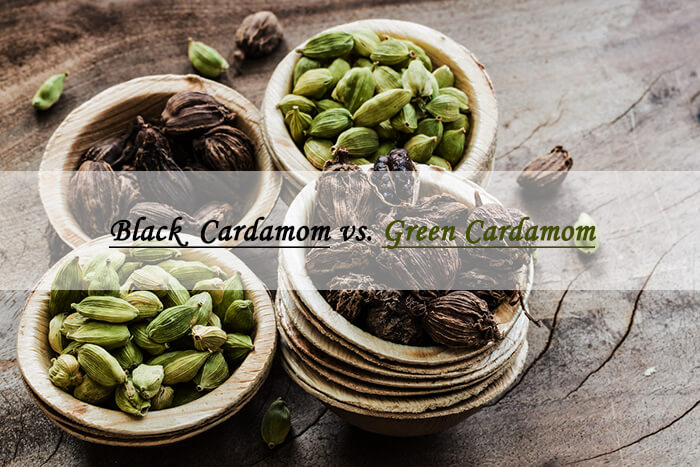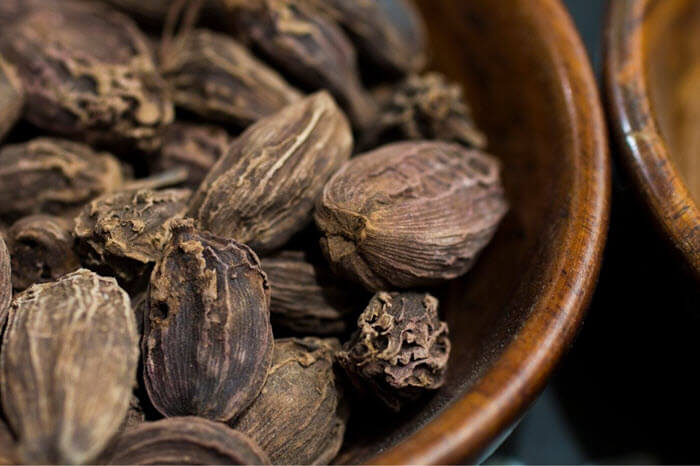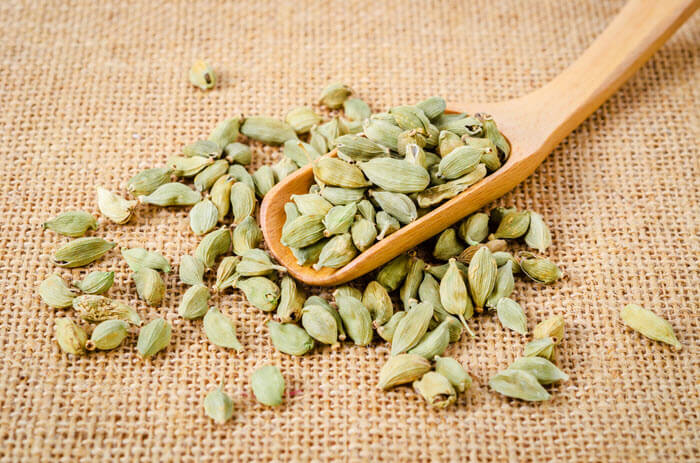Affectionately known as the “queen of spices,” cardamom is an aromatic and unique spice with many uses.
The spice is a member of the ginger family. It is also native to South Asia and is an ingredient in sweet and savory Indian, Middle Eastern, and Asian cuisine.
There are two common forms of cardamom, black and green.
Today we will break down the differences between black cardamom and green cardamom, including their physical characteristics, flavors, and health benefits.
Table Of Contents
What Is Black Cardamom?
Black cardamom is a bold, camphor, and smoky-flavored spice that grows in brown pods.
The pods are roughly one inch long and have a tough, wrinkly exterior. Inside the pod are tiny, black seeds used for cooking.
Black cardamom pods are dried over an open flame, increasing their natural smoky flavor.
The pods can be cooked whole or ground into a fine powder. Some recipes call for only the seeds, which are ground. The ground seeds will be more potent and flavorful if they are fresh.
This unique, slightly funky spice is also known as a warming spice. This categorization puts it alongside other smoky spices that have a bit of a bite, such as black pepper and cloves.
Some Indian recipes that call for black cardamom include dals and curries. Other cultures use black cardamom to enhance the flavor of braised meat or pho soup.
What Is Green Cardamom?
Green cardamom, also called chhoti elaichi, also grows in pods. This “true cardamom” is a surprising mixture of scents, including citrus, mint, pepper, and eucalyptus.
It is more herbal than black cardamom and is prominent in popular spice blends like garam masala.
Green cardamom is an ingredient in famous beverages like Turkish coffee and masala chai. It is often a part of sweet dishes, pairing well with spices like cloves, vanilla, and cinnamon.
Recipes that call for green cardamom include apple pie, cheesecake, bread pudding, and mulled wine.
The blend of herbal and spice lends a pleasant warmth to these traditionally sweet and sugary desserts. Green cardamom is also a key ingredient in Kheer, an Indian rice pudding.
Differences Between Black and Green Cardamom
There are several differentiating factors between black and green cardamom.
Black Cardamom | Green Cardamom | |
Flavor | Smoky and camphor-like flavor | Strong and intense |
Processing | Harvested much later | Harvest happens before the plant matures |
Pods | Tough, wrinkly skins and a dark brownish-black color | Smaller and a light-green color |
Seeds | 8-16 seeds per pod | About 20 seeds per pod |
Price | Cheaper | More expensive |
Uses | Savory dishes | Sweet and savory dishes |
Green Cardamom Pods vs. Black Cardamom Pods
One of the main differences between green and black cardamom is their pods.
Green Cardamom
The pods from green cardamom plants stay green because harvest happens before the plant matures.
Green cardamom pods are much smaller and have a light-green color. The flavor of green cardamom pods is much stronger than black cardamom pods.
However, it is usable in both sweet and savory dishes. Both the pod and the seeds are suitable for cooking.
Black Cardamom
Harvest for black cardamom happens later than harvest for green cardamom. As a result, the black cardamom pods are much more sizable.
They have tough, wrinkly skins and are a dark brownish-black color. Because of the pods’ tough exterior, only the seeds should be a part of your recipe.
Green vs. Black Cardamom Seeds
The seeds from green and black cardamom pods are removed and ground to a fine powder before being added to a recipe.
Green Cardamom
The seeds from green cardamom are small, round, and black. These seeds look similar to peppercorns and have a sweet, herbal scent. Each pod holds approximately twenty seeds.
Black Cardamom
Black cardamom seeds have a strong, pungent aroma and a menthol-like flavor. They are also small and black, but there are only between 8 and 16 seeds per pod.
These seeds are better suited to rich, savory, and spicy foods.
Black Cardamom vs. Green Cardamom Health Benefits
As for health benefits, both black and green cardamom have similar abilities. The herbs have been in use for medicinal purposes for hundreds of years.
Cardamom’s high concentration of magnesium and antioxidants are proven to help manage blood sugar and lower blood pressure levels.
It is also excellent for reducing inflammation, improving glucose intolerance for weight loss [1], assisting with mood disorders like anxiety, and treating ulcers, constipation, and other gastrointestinal problems.
Cardamom has long been a spice for maintaining good oral health [2] as well. The spice targets mouth bacteria when chewed directly, treating immediate poor breath and preventing cavities.
Some early research suggests that cardamom may help reduce the risk of cancer [3]. When eaten in powder form, the spice supports existing enzymes in the body that can attack cancerous tumors.
FAQs About Black/Green Cardamom
Let’s address some frequently asked questions about green and black cardamom, including substitutions and recipe usage.
Can I substitute green cardamom for black cardamom?
Although the flavor profiles of green and black cardamom are drastically different, you can substitute green cardamom for black in a pinch. However, it is not advisable.
Black cardamom’s bold, smoky, and menthol-like flavor can easily overwhelm sweet desserts and loaves of bread that call for the sweet and floral green cardamom.
Is black cardamom better than green?
Neither black nor green cardamom is better than the other. They are different spices that serve different purposes in various styles of cuisine.
In some cases, black cardamom is a more suitable selection for a recipe than green cardamom.
- For cooking a savory Asian noodle dish like pho, basmati rice, or a spicy curry, black cardamom will be the best choice.
- Black cardamom is not better than green cardamom for desserts, as it can overpower the sweetness with its camphor flavor and aroma.
Can I use black cardamom for chai?
Traditional masala chai is a delightfully spicy mixture of black tea, ginger, milk, green cardamom, and sweet baking spices like vanilla or cinnamon. The rich, smoky flavor of black cardamom also makes for a lovely, well-rounded chai.
- If you want to experiment with black cardamom in your chai tea, it is a good idea to use it alongside a pod of green cardamom. The use of both will ensure the best blend of both flavor profiles.



